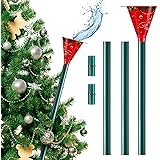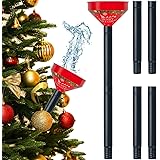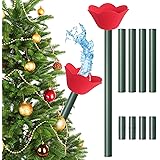Do you want to know the difference between a swale and a french drain? Swale vs french drain is a common question for those new to lawn management. Whether you’re looking for an efficient and economical way to divert runoff or aiming for a greener and healthier home lawn, swales and french drains are powerful tools to achieve these goals.
Both systems structurally provide a way for water to be diverted away from areas, protecting your home and lawn, although there are a few key differences. In this article, we’ll explain the differences between a swale and french drain and how to know which one is best for you.
Differences Between Swale and French Drain
| Specifications | Swale | French Drain |
|---|---|---|
| Typical Installation | Generally designed alongside roadways and other hard surfaces, like a ditch along the roadside or at the base of the retained earth. | Typically installed along the edges of a home or building foundation or within the lawn to manage surface runoff. |
| Design | Generally designed with an inherently low grade (between 0.5% and 2%) to allow surface water to slowly flow through | Typically designed with a very low grade (1/8″-1/4″) to funnel surface water through a perforated pipe. |
| Uses | Can be used for erosion control, water retention, and to temporarily hold, filter, and slowly release surface runoff. | Generally used to filter surface water away from building foundations, and reduce the saturation of the soil near the property line. |
| Maintenance | May require periodic de-silting, cleaning, enlarging, and/or straightening in order to maintain proper drainage. | Will require occasional auguring or trenching to inspect, repair, or replace the perforated pipe. |
Swales and French drains are two very different options when it comes to controlling the flow of surface water around a home or other structure.
A swale is generally designed with an inherently low grade (between .5% and 2%) to allow surface water to slowly flow through it, while a French drain is designed with a very low grade (1/8″-1/4″) to funnel surface water through a perforated pipe.
The typical installation for each is also different. Swales are generally designed alongside roadways and other hard surfaces, like a ditch along the roadside or at the base of the retained earth. French drains, meanwhile, are typically installed along the edges of a home or building foundation or within the lawn to manage surface runoff.
When looking at the uses for each, swales can be used for erosion control, water retention, and to temporarily hold, filter, and slowly release surface runoff, while French drains are generally used to filter surface water away from building foundations, and reduce the saturation of the soil near the property line.
Maintenance is yet another difference between swales and French drains. A swale may require periodic de-silting, cleaning, enlarging, and/or straightening in order to maintain proper drainage, while a French drain will require occasional auguring or trenching to inspect, repair, or replace the perforated pipe.
Overall, both swales and French drains can be effective solutions for managing surface water runoff. The key is to understand the differences in their designs, uses, and maintenance requirements so that you can select the option that best meets your needs and budget.
Swale vs French Drain: A Definitive Guide
Swales and French drains are two of the most popular methods of water management on residential, commercial and agricultural properties. Understanding the differences between the two options can have a huge impact on the success of your landscaping project and can help prevent water damage to your property.
In this guide, we’ll take you through the basic concepts of swales and French drains, the tools and materials you’ll need to get the job done, and the pros and cons of each technique.
What is a Swale?
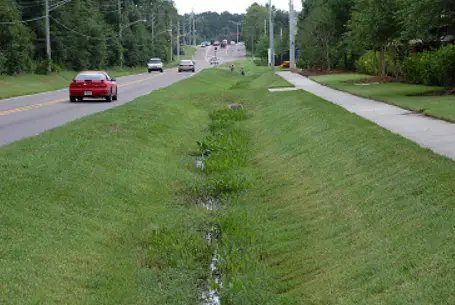
A swale is a shallow, elongated depression in the ground that’s designed to direct water flow away from an area. It may be created naturally by erosion or manually by digging the soil into a depression with a tool like a backhoe.
Swales typically have gently-sloping sides and usually a flat bottom. They’re usually designed to drain water from a single area and can be lined with vegetation to help slow erosion and improve water retention. Swales are often used to divert surface water runoff away from a house and out towards something like a retention pond, a ditch, or a dry stream bed.
What is a French Drain?
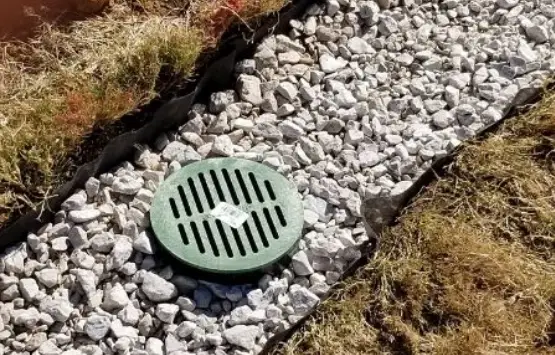
A French drain is also a method to manage excess water flow in a landscaping project. It involves installing a pipe with a perforated bottom and layers of gravel and stone around it, in a depression or trench in the ground.
When water accumulates in the drainage trench, it will fill the system and be piped to a collection area. French drains are typically placed along the foundation of a building to divert water away from the structure or at the base of a slope to help control erosion.
Swale vs French Drain: Tools and Materials
You’ll need different tools and materials for a swale and a French drain. Here’s a brief overview of the supplies needed for each:
Swale
- A shovel or spade, a wheelbarrow, and a mattock
- Compost or soil additives, depending on soil quality
- Rocks or wood chips
- Native vegetation
French Drain
- A shovel or spade, a wheelbarrow, and a post hole digger
- Perforated plastic piping
- A variety of gravel and stone
- Heavy fabric (for wrapping the pipe)
- Sand
- Plastic sheeting (to cover the drain)
The exact type of materials and tools needed will depend on your specific project, so be sure to do some research about your local climate and soil conditions.
Advantages of Swales and French Drains
Swales and French drains can both be extremely effective for managing water runoff. Here are some of the main advantages of each system:
Benefits of Swales
- Directs water flow away from buildings, roads, and other areas in need of protection from flooding and erosion.
- Can be used to transport surface water to areas of the landscape that need it.
- Aesthetically pleasing, often incorporated into landscaping designs quite naturally.
- Can help recharge groundwater because they are designed to capture and transport runoff into an area where it can slowly infiltrate into the ground.
Benefits of French Drains
- Highly efficient at diverting water away from a structure.
- Can be designed in many shapes and sizes to fit any budget or project.
- Improves soil and plant health by preventing waterlogging.
- Easy to customize, including adjustments to the pipe layout, the slope of the French drain, and the amount of gravel used.
Softscaping vs Hardscaping for Swales and French Drains
Softscaping is the process of planting vegetation and other organic materials in an area. This is usually done in swales, where vegetation can help limit erosion and better absorb water. Typical softscaping materials include native plants, shrubs, trees, sod, and soil additives like compost.
Hardscaping, on the other hand, involves the use of rocks, stones, and other non-organic materials. This is typically used in French drains to add more structural stability and improve drainage. Common hardscaping materials used in French drains include limestone, gravel, sand, and plastic sheeting.
Pros and Cons of Swales vs French Drains
In addition to the advantages of swales and French drains, it’s important to consider the cons of each system before making a decision. Here’s a quick overview of the pros and cons of swales and French drains:
Swales
Pros:
- Easy to install and maintain
- Inexpensive
- Improves water conservation and recharge groundwater
- Can be planted to minimize soil erosion and add aesthetic value
Cons:
- Installation can be labor-intensive depending on the size and scope of the project
- Timing is important – swales must be maintained in order to function properly
- May not be effective for unusually heavy water runoff
French Drains
Pros:
- Highly efficient for controlling water runoff
- Highly customizable
- Easy to install and relatively low maintenance
Cons:
- Materials and installation are more expensive than swales
- Can be unsightly when not properly maintained
- Heavy materials are difficult to rearrange and may need to be completely removed if the landscape design changes
Installing Swales and French Drains
Installing either a swale or a French drain requires a lot of effort and preparation. Here’s a quick summary of each installation process:
Installing a Swale
- Dig out the desired area to create a shallow depression.
- Improve soil quality and fertility with soil additives like compost.
- Add vegetation and mulch to reduce erosion and improve water infiltration.
- Construct any necessary retaining walls to keep plants and soil in place.
- Add rocks or wood chips to the sides of the swale to help slow water flow.
- Connect the swale to an appropriate drainage area.
Installing a French Drain
- Dig a trench in the desired area that’s wide enough for the pipe and gravel.
- Reach a depth of 1-2 feet below the quality soil line.
- Lay the perforated pipe in the bottom of the trench.
- Cover with an inch of sand and a layer of heavy fabric for additional protection.
- Add a 2-3 inch layer of gravel around the pipe.
- Cover the gravel with another layer of fabric and a layer of stones or large rocks.
- Cover with three inches of topsoil.
- Connect the French drain to an appropriate drainage area with a hose.
Frequently Asked Questions (FAQs) About Swales vs French Drains
A swale is a shallow, wide form of drainage ditch that is often lined with grass and/or vegetation. Swales are able to absorb and slowly release runoff and precipitation.
They are typically used in landscaping or urban design to control erosion and movement of water, and ultimately to direct the water away from buildings and structures.
A French drain is a trench filled with gravel and a perforated pipe that collects and redirects water. The pipe is typically covered with a material that allows water to enter but prevents dirt and other debris from clogging the pipe.
French drains can be used to remove water from gardens, agricultural fields, or wherever standing water is present.
The main difference between a swale and a French drain is the method by which water is managed. Swales absorb and slowly release water, while French drains redirect and convey the water away from an area.
Swales therefore are best used in areas where water needs to be stored and allowed to slowly percolate into the ground, while French drains can be used to more actively manage and redirect water.
The effectiveness of swales vs french drains depends on the context in which they are used. In some cases, a French drain may be more effective for controlling runoff due to its ability to more actively and quickly redirect water away from an area.
However, in other cases a swale may be more effective, as it can act as a reservoir and store water for more controlled release.
Swales are more commonly used in landscaping and urban design, while French drains are more commonly used to actively manage standing water in gardens and agricultural fields.
The cost of installing swales or French drains will vary greatly depending on the context and materials used.
The cost of installing a swale may range from a few hundred dollars to several thousand, while the cost of a French drain may range from a few hundred dollars to a few thousand (for larger trenches). A full cost breakdown can be provided by a local contractor.
The materials required for swales and French drains vary based on the context and the desired outcome.
Swales typically require vegetation, soil, a liner, and possibly an overflow system. French drains typically require a trench, gravel, a perforated pipe, and a filter fabric to prevent clogging.
Installing a swale or French drain yourself is entirely possible, though the complexity of the task will vary depending on the context.
If you are not skilled in landscaping or civil engineering, it is recommended to contact a local contractor.
Wrapping Things Up
When it comes to drainage solutions, a Swale and a French Drain have plenty in common. Both are effective at helping divert water away from an area. However, they do have their differences too. For starters, French Drains require trenches lined with gravel and a pipe filled with perforations, while Swales are simply flat, land-based channels. The drainage abilities of both are also very different. Swales will hold the water and help it spread, while French Drains are designed to channel the water away quickly.
In summary, the choice between Swales and French Drains will depend on your environment and the amount of water you need to drain. If yours is an area with flat land and with large amounts of rain or snowfall, then a Swale might be your best option. If, however, you need to drain a smaller area quickly, then a French Drain should be your choice. Either way, it’s important to understand the differences between a Swale and a French Drain before making your decision.
Auto Amazon Links: No products found.
Perfect Plants Christmas Tree Saver 8oz. | Easy Use Xmas Tree Preserver Food | Have Healthy Green Christmas Trees All Holiday Season
$9.97 (as of December 11, 2025 04:08 GMT +00:00 - More info- Product prices and availability are accurate as of the date/time indicated and are subject to change. Any price and availability information displayed on [relevant Amazon Site(s), as applicable] at the time of purchase will apply to the purchase of this product.
Rocky Mountain Goods Christmas Tree Food - 8 oz Tree Preservative - Reduce Needle Drop - Greener Scent - Fir, Pine, Spruce Trees - Extend Tree Life
$9.95 (as of December 11, 2025 04:08 GMT +00:00 - More info- Product prices and availability are accurate as of the date/time indicated and are subject to change. Any price and availability information displayed on [relevant Amazon Site(s), as applicable] at the time of purchase will apply to the purchase of this product.
VICAMB 39.3 Inch Christmas Tree Watering Funnel,Christmas Tree Watering System Device,Long Tree Watering Funnel Spout for Indoor Outdoor Xmas Tree
$16.99 (as of December 11, 2025 04:08 GMT +00:00 - More info- Product prices and availability are accurate as of the date/time indicated and are subject to change. Any price and availability information displayed on [relevant Amazon Site(s), as applicable] at the time of purchase will apply to the purchase of this product.
SUNEZLGO Christmas Tree Watering Funnel, Christmas Tree Watering System Tree Waterer, Real Christmas Tree Water Funnel, Xmas Adjustable Metal Tubes Spout for Indoor Outdoor Christmas Tree
$19.99 (as of December 11, 2025 04:08 GMT +00:00 - More info- Product prices and availability are accurate as of the date/time indicated and are subject to change. Any price and availability information displayed on [relevant Amazon Site(s), as applicable] at the time of purchase will apply to the purchase of this product.
EZMeetU Christmas Tree Watering Funnel, 47 Inch Flower Shape Adjustable 6 Section Design, Christmas Tree Watering System, Christmas Tree Waterer, Long Funnel Wide Opening Reusable, Plant Watering Tool
$16.99 (as of December 11, 2025 04:08 GMT +00:00 - More info- Product prices and availability are accurate as of the date/time indicated and are subject to change. Any price and availability information displayed on [relevant Amazon Site(s), as applicable] at the time of purchase will apply to the purchase of this product.
Snow Joe Premium Enviro Blend Ice Melt, Green-Coated Deicer Crystals, 50 lb - Safer Melter for Vegetation, Concrete & Metals w/ Anti-Corrosion Calcium Magnesium Acetate
$32.97 (as of December 11, 2025 19:12 GMT +00:00 - More info- Product prices and availability are accurate as of the date/time indicated and are subject to change. Any price and availability information displayed on [relevant Amazon Site(s), as applicable] at the time of purchase will apply to the purchase of this product.
Muddy Mat® Shown on TV Super Absorbent Microfiber Dog Door Mat for Muddy Paws, Non-Slip Washable Pet Rug, Quick Dry Chenille Entryway Carpet, Machine Washable Indoor Outdoor mat, Grey 30"x19"
$24.95 (as of December 11, 2025 19:12 GMT +00:00 - More info- Product prices and availability are accurate as of the date/time indicated and are subject to change. Any price and availability information displayed on [relevant Amazon Site(s), as applicable] at the time of purchase will apply to the purchase of this product.
ivtivfu Rolling Grill Basket, Removable Wooden Handle, 304 Stainless Steel, Nesting BBQ Tools, Smoker Grilling Accessories for Vegetable, Outdoor Cooking Camping, Birthday Gifts for Men Dad Husband
$25.99 (as of December 11, 2025 19:12 GMT +00:00 - More info- Product prices and availability are accurate as of the date/time indicated and are subject to change. Any price and availability information displayed on [relevant Amazon Site(s), as applicable] at the time of purchase will apply to the purchase of this product.
XXXFLOWER Plant Terrarium with Wooden Stand, Air Planter Bulb Glass Vase Metal Swivel Holder Retro Tabletop for Hydroponics Home Garden Office Decoration - 3 Bulb Vase
$18.98 (as of December 11, 2025 19:12 GMT +00:00 - More info- Product prices and availability are accurate as of the date/time indicated and are subject to change. Any price and availability information displayed on [relevant Amazon Site(s), as applicable] at the time of purchase will apply to the purchase of this product.
Zevo Flying Insect Trap Official Refill Cartridges - Fits Both Zevo Trap & MAX Indoor Fly Trap - Authentic Trap+Lock Technology to Catch Gnats, House & Fruit Flys (4 Official Refill Cartridges)
$14.97 (as of December 11, 2025 19:12 GMT +00:00 - More info- Product prices and availability are accurate as of the date/time indicated and are subject to change. Any price and availability information displayed on [relevant Amazon Site(s), as applicable] at the time of purchase will apply to the purchase of this product.



